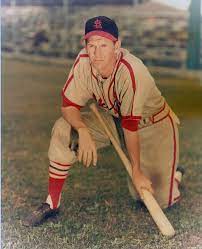Inductees
Marty Marion

December 1, 1916—March 15, 2011
Nicknamed “Slats”, Marion had unusually long arms which reached for grounders like tentacles, prompting sportwriters to call him “The Octopus”.
From 1940-50, Marion led the National League shortstops in fielding percentage four times, despite several other players being moved around the infield during these years. In 1941 he played all 154 games at shortstop (also a league-high).
Marion was also a better-than-average hitter for a shortstop. His most productive season came in 1942, when he hit .276 with a league-leading 38 doubles. In the 1942 World Series, one of four series in which he participated with the Cardinals, he helped his team to a World Championship. In 1943 he batted a career-high .280 in the regular season and hit .357 in the 1943 World Series.
In 1951 Marion managed the Cardinals and was replaced by Eddie Stanky at the end of the season. He moved to the American League Browns and took over for manager Rogers Hornsby early in 1952 as their player-manager. The last manager in St. Louis Browns history, he was let go after the 1953 season when the Browns moved to Baltimore. He then signed as a coach for the White Sox for the 1954 campaign and was promoted to manager that September, when skipper Paul Richards left Chicago to become field manager and general manager in Baltimore. Marion led the White Sox for two and half seasons, finishing third each time, before he stepped down at the end of the 1956 season.
In 1958, Marion purchased the Double-A minor league Houston Buffaloes from the St. Louis Cardinals, and successfully moved the team to the Triple-A level under the Chicago Cubs farm system.
In a 13-season career, Marion posted a .263 batting average with 36 home runs and 624 RBI in 1572 games. He made All-Star Game appearances from 1943–44 and 1946-1950 (There was no All-Star Game in 1945). In 1944 he earned the National League Most Valuable Player Award. As a manager, he compiled a 356-372 record.